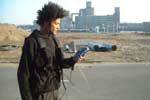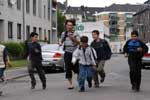Can You See Me Now? draws upon the near ubiquity of handheld electronic
devices in many developed countries. Blast Theory are fascinated
by the penetration of the mobile phone into the hands of poorer
users, rural users, teenagers and other demographics usually excluded
from new technologies.
Some research has suggested that there is a higher usage of mobile
phones among the homeless than among the general population. The
advent of 3G brings constant internet access, location based services
and massive bandwidth into this equation. Can You See Me Now?
is a part of a sequence of works (Uncle Roy All Around You and
I Like Frank are subsequent works) that attempt to establish a
cultural space using these devices.
These social forces have dramatic repercussions for the city.
As the previously discrete zones of private and public space (the
home, the office etc.) have become blurred, it has become commonplace
to hear intimate conversations on the bus, in the park, in the
workplace. And these conversations are altered by the audience
that accompanies them: we are conscious of being overheard and
our private conversations become three way: the speaker, the listener
and the inadvertent audience. Can You See Me Now? takes the fabric
of the city and makes our location within it central to the game
play.
The piece uses the overlay of a real city and a virtual city
to explore ideas of absence and presence. By sharing the same
'space', the players online and runners on the street enter into
a
relationship that is adversarial, playful and, ultimately, filled
with pathos.
As soon as a player registers they must answer the question:
"Is there someone you haven't seen for a long time that you
still think of?". From that moment issues of presence and
absence run through Can You See Me Now?.
This person who has not been seen for a long time - absent in
place and time - seems irrelevant to the subsequent game play;
only at the point that the player is caught or 'seen' by a runner
do they hear the name mentioned again as part of the live audio
feed from the streets of the city. The last words they hear are
"Runner 1 has seen ______ _______". With the advent
of virtual spaces and, more recently, hybrid spaces in which virtual
and real worlds are overlapping, the emotional tenor of these
worlds has become an important question. In what ways can we talk
about intimacy in the electronic realm. In Britain the internet
is regularly characterised in the media as a space in which paedophiles
'groom' unsuspecting children and teenagers. Against this back
drop can we establish a more subtle understanding of the nuances
of online relationships. When two players who know one another
place their avatars together and wait for the camera view to zoom
down to head height so that the two players regard one another,
what is going on? Is this mute tenderness manifest to anyone else
and should it be?
And alongside these small moments, there is a louder and more
forceful set of interactions between runners and players based
on insults, teasing, goading and humour. These public declarations
seem to happily coexist with the private moments that appear marginal
to the casual observer. Yet, this
demotic discourse also can surprise: the online players understanding
that the runners are tired, hot, struggling with the environment
on the street can become a powerful emotion. A player from Seattle
wrote: "I had a definite heart stopping moment when my concerns
suddenly switched from desperately trying to escape, to desperately
hoping that the runner chasing me had not been run over by a reversing
truck (that's what it sounded like had happened)."
Blast Theory is renowned internationally as one of the most
adventurous artists' groups using interactive media. Lead by Matt
Adams, Ju Row Farr and Nick Tandavanitj the group has a team of
six and is based in London. The group's work explores interactivit
and the relationship between real and virtual space with a particular
focus on the social and political aspects of technology. It confronts
a media saturated world in which popular culture rules, using
video, computers, performance, installation, mobile and online
technologies to ask questions about the ideologies present in
the information that envelops us. Blast Theory won the much coveted
Prix Ars Electronica for Interactive Art in 2003.
Text originally published in ArtFutura's 2004 catalog.







